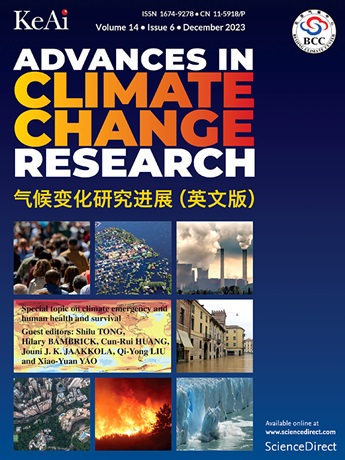在《巴黎协定》2°C目标下,中国各省实现碳中和的代表性二氧化碳排放路径
IF 5.2
1区 地球科学
Q1 ENVIRONMENTAL SCIENCES
引用次数: 0
摘要
中国承诺到2060年实现碳中和。必须在省级层面制定具有代表性的二氧化碳排放路径,与国家目标保持一致,以促进有效的政策实施和科学研究。为了解决各省总排放量与国家估算的不一致问题,本研究比较了自下而上的排放因子法和自上而下的大气CO2浓度反演法对中国各省2021年CO2排放量的估算。我们发现,这些方法对省一级的能源燃烧和工业过程的排放产生了可比的结果。在回顾中国各省二氧化碳排放路径研究现状的基础上,提出了具有代表性的中国各省二氧化碳排放路径。这些路径与过去将国家排放强度降低目标分配给各省的做法一致,也与清华- cma的国家路径一致。拟议的路径要求各省在2030年之前依次达到排放峰值,然后快速减排。与没有碳中和目标的参考情景相比,这些途径在2020年至2060年间估计将导致GDP累计损失约1%。然而,区域差异明显,由于高质量低碳资源的可用性,西北一些地区可能会经历更高的经济增长。我们建议中国通过自下而上和自上而下的交叉验证方法加强省级二氧化碳排放核算。此外,在更新碳中和途径时,应仔细考虑将省级目标与国家和全球承诺保持一致。本文章由计算机程序翻译,如有差异,请以英文原文为准。
Representative CO2 emissions pathways for China's provinces toward carbon neutrality under the Paris Agreement's 2 °C target
China has committed to achieving carbon neutrality by 2060. It is essential to develop representative CO2 emissions pathways at the provincial level that align with the national target to facilitate effective policy implementation and scientific research. To address inconsistencies between provincial aggregate emissions and national estimates, this study compares the 2021 CO2 emissions estimates of China's provinces from the bottom‒up emissions factor method and the top‒down atmospheric CO2 concentration inversion method. We find that these methods yield comparable results for the emissions from energy combustion and industrial processes at the provincial level. Based on a review of existing research on CO2 pathways for China's provinces, we propose a set of representative pathways for China's provinces. These pathways align with past practices of allocating national emissions intensity reduction targets to provinces and are consistent with the national Tsinghua‒CMA pathway. The proposed pathways require provinces to sequentially peak their emissions by 2030, followed by rapid emissions reduction. Compared to a reference scenario without the carbon neutrality target, these pathways would incur an estimated cumulative GDP loss of about 1% between 2020 and 2060. However, there are notable regional variations, with some regions in the northwest potentially experiencing higher economic growth due to the availability of high-quality low-carbon resources. We recommend that China enhance provincial-level CO2 emissions accounting by cross-validating bottom‒up and top‒down methods. Additionally, careful consideration should be given to aligning provincial targets with national and global commitments when updating pathways toward carbon neutrality.
求助全文
通过发布文献求助,成功后即可免费获取论文全文。
去求助
来源期刊

Advances in Climate Change Research
Earth and Planetary Sciences-Atmospheric Science
CiteScore
9.80
自引率
4.10%
发文量
424
审稿时长
107 days
期刊介绍:
Advances in Climate Change Research publishes scientific research and analyses on climate change and the interactions of climate change with society. This journal encompasses basic science and economic, social, and policy research, including studies on mitigation and adaptation to climate change.
Advances in Climate Change Research attempts to promote research in climate change and provide an impetus for the application of research achievements in numerous aspects, such as socioeconomic sustainable development, responses to the adaptation and mitigation of climate change, diplomatic negotiations of climate and environment policies, and the protection and exploitation of natural resources.
 求助内容:
求助内容: 应助结果提醒方式:
应助结果提醒方式:


